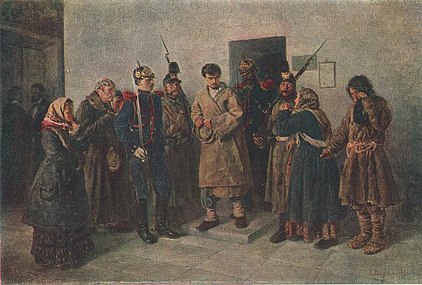Vladimir Makovsky
Vladimir Makovsky | |
|---|---|
| Владимир Маковский | |
| Education | Member Academy of Arts (1873) Full Member Academy of Arts (1893) Professor by rank (1894) |
| Alma mater | Moscow School of Painting, Sculpture and Architecture |
| Known for | Painting |
| Movement | Peredvizhniki |
Vladimir Yegorovich Makovsky (Russian: Владимир Егорович Маковский; 7 February [O.S. 26 January] 1846 – 21 February 1920) was a Russian painter, art collector, and teacher.
Biography
Makovsky was the son of collector,
Makovsky's work was defined by a perpetual humor as well as blatant irony and scorn. During the seventies his paintings dealt primarily with small-town folk. His pictures, "The Grape-juice Seller" (1879), "Fruit-Preserving" (1876) and "The Congratulator" (1878) depict various scenes where the mood is finely conceived and almost laughter-inducing. Other works of his, such as "The Benefactor" (1874) and "The Convict" (1878) are profoundly socially conscious. In them, Makovsky either criticizes the false sympathy of the aristocracy towards the poor, or draws attention to the oppression and persecution by the tsarist gendarmerie. In 1878, he became an academician.
In the eighties, during the time of Russian "democratic" painting, Makovsky produced some of his most valued works. In 1882, he was made professor at the Moscow Art School after the death of
In 1894, Makovsky became Rector of the Preparatory school of the Academy of Art. After the First Russian Revolution, he painted "January 9, 1905, on Vasilyev Island" in which he depicts the armed police firing at defenseless people. In another painting "The Sacrifices on the Khodyn Field" in which a thousand people lost their lives during the coronation ceremony in 1896 of
Selected paintings
-
Portrait of painter Sergei Korovin[1] (1892)
-
Portrait ofEmpress Maria Fyodorovna[2](1885)
-
Not Guilty
-
Party
-
Convicted
-
Philanthropists(1874)
-
His First Suit
-
Bankruptcy
-
Market in Poltava
-
Mother and Daughter
-
The cow (1874) lithography
-
Departure for the Hunt (1899)
References
- National Museum in Warsaw.
- ^ Gatchina Palace.
- Vladimir Fiala, Russian Painting of the 18th and 19th Centuries, translated by Jean Layton, Artia, 1981

![Portrait of painter Sergei Korovin[1] (1892)](http://upload.wikimedia.org/wikipedia/commons/thumb/1/18/Makovsky_Sergey_Korovin.jpg/185px-Makovsky_Sergey_Korovin.jpg)
![Portrait of Empress Maria Fyodorovna[2] (1885)](http://upload.wikimedia.org/wikipedia/commons/thumb/3/32/Maria_Fedorovna_by_V.Makovskiy_%281912%2C_Russian_museum%29.jpg/206px-Maria_Fedorovna_by_V.Makovskiy_%281912%2C_Russian_museum%29.jpg)









